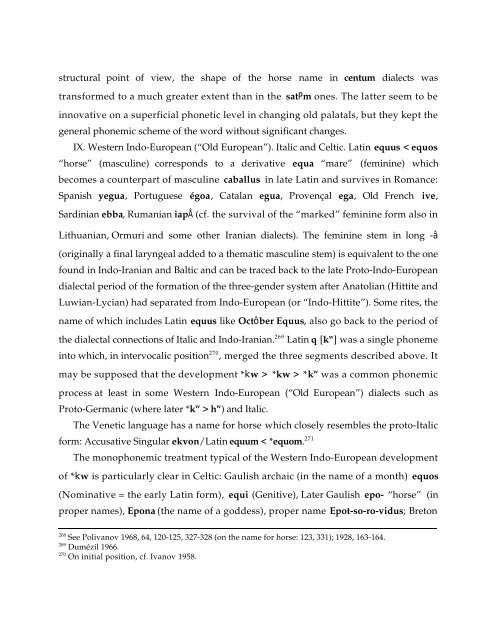Comparative Notes on Hurro-Urartian, Northern Caucasian
Comparative Notes on Hurro-Urartian, Northern Caucasian
Comparative Notes on Hurro-Urartian, Northern Caucasian
You also want an ePaper? Increase the reach of your titles
YUMPU automatically turns print PDFs into web optimized ePapers that Google loves.
structural point of view, the shape of the horse name in centum dialects was<br />
transformed to a much greater extent than in the satPm <strong>on</strong>es. The latter seem to be<br />
innovative <strong>on</strong> a superficial ph<strong>on</strong>etic level in changing old palatals, but they kept the<br />
general ph<strong>on</strong>emic scheme of the word without significant changes.<br />
IX. Western Indo-European (“Old European”). Italic and Celtic. Latin equus < equos<br />
“horse” (masculine) corresp<strong>on</strong>ds to a derivative equa “mare” (feminine) which<br />
becomes a counterpart of masculine caballus in late Latin and survives in Romance:<br />
Spanish yegua, Portuguese égoa, Catalan egua, Provençal ega, Old French ive,<br />
Sardinian ebba, Rumanian iapÅ (cf. the survival of the “marked” feminine form also in<br />
Lithuanian, Ormuri and some other Iranian dialects). The feminine stem in l<strong>on</strong>g -â<br />
(originally a final laryngeal added to a thematic masculine stem) is equivalent to the <strong>on</strong>e<br />
found in Indo-Iranian and Baltic and can be traced back to the late Proto-Indo-European<br />
dialectal period of the formati<strong>on</strong> of the three-gender system after Anatolian (Hittite and<br />
Luwian-Lycian) had separated from Indo-European (or “Indo-Hittite”). Some rites, the<br />
name of which includes Latin equus like Octôber Equus, also go back to the period of<br />
the dialectal c<strong>on</strong>necti<strong>on</strong>s of Italic and Indo-Iranian. 269 Latin q [k w ] was a single ph<strong>on</strong>eme<br />
into which, in intervocalic positi<strong>on</strong> 270 , merged the three segments described above. It<br />
may be supposed that the development *´kw > *kw > *k w was a comm<strong>on</strong> ph<strong>on</strong>emic<br />
process at least in some Western Indo-European (“Old European”) dialects such as<br />
Proto-Germanic (where later *k w > h w ) and Italic.<br />
The Venetic language has a name for horse which closely resembles the proto-Italic<br />
form: Accusative Singular ekv<strong>on</strong>/Latin equum < *equom. 271<br />
The m<strong>on</strong>oph<strong>on</strong>emic treatment typical of the Western Indo-European development<br />
of *´kw is particularly clear in Celtic: Gaulish archaic (in the name of a m<strong>on</strong>th) equos<br />
(Nominative = the early Latin form), equi (Genitive), Later Gaulish epo- “horse” (in<br />
proper names), Ep<strong>on</strong>a (the name of a goddess), proper name Epot-so-ro-vidus; Bret<strong>on</strong><br />
268 See Polivanov 1968, 64, 120-125, 327-328 (<strong>on</strong> the name for horse: 123, 331); 1928, 163-164.<br />
269 Dumézil 1966.<br />
270 On initial positi<strong>on</strong>, cf. Ivanov 1958.





